Matador Network's Blog, page 734
December 9, 2020
American Airlines at-home testing

Currently, 14 US cities, territories, and states have introduced travel restrictions and requirements to help curb the spread of COVID-19. To help domestic travelers make it to their destinations this holiday season, starting December 9, American Airlines is partnering with LetsGetChecked to launch at-home, domestic preflight COVID-19 testing.
This means that American Airlines passengers flying to any US city, state, or territory with COVID-19 travel restrictions in place will have access to at-home testing through LetsGetChecked.
The 14 US cities, territories, and states that have travel restrictions are:
Alaska
Connecticut
District of Columbia
Chicago
Hawaii
Maine
Maryland
Massachusetts
New Hampshire
New York
Pennsylvania
Puerto Rico
Rhode Island
Vermont
Aliso Taylor, the chief customer officer for American Airlines, said in a press release, “We’ve made great strides to help open international travel with our testing partners, and we recognize the need for similar domestic travel solutions. As travel requirements continue to quickly evolve, we’re simplifying the research and COVID-19 testing fulfillment process for an overall more seamless travel experience.”
The at-home tests will cost $129 each, and passengers are encouraged to order the test at least five days prior to their flight. They can then schedule a UPS pickup of their testing sample and expect results within 48 hours through an online portal. 
More like thisTravel SafetyCan we trust negative COVID-19 tests as a green light for travel? We asked a travel doctor.
The post American Airlines offers at-home testing for all US destinations with COVID-19 requirements appeared first on Matador Network.

Hotwire is giving away $25,000 trip

Health experts agree that to stay safe this winter, it’s best for everyone to stay home for the holidays. While that’s certainly a bummer, online travel site Hotwire is offering the mother of all consolation prizes. It’s giving away a $25,000 luxury “IOU” trip for the whole family, to get you excited about traveling again in the future.
The giveaway was inspired by a recent Hotwire survey that found over 80 percent of Americans are altering or canceling their holiday travel plans due to the COVID-19 pandemic and resulting travel restrictions. Even more interestingly, 28 percent said they’re delaying telling their family about their canceled plans, putting off the uncomfortable phone call until at least mid-December.
That’s why Hotwire built a “Happy Next Holidays” message generator, which creates funny messages that let your family down gently. When you generate your message you’ll be automatically entered to win the grand “IOU” luxury trip, redeemable at a domestic destination. Hotwire will cover your flights and hotel, and throw in an extra $15,580 in cash for you to spend on memorable experiences.
Nick Graham, head of Hotwire, said in a statement, “We know that this year has been tough on everyone, to say the least, and people are really feeling the stress as we head into the holiday season — a time that under normal circumstances, we reunite with family and friends from around the country. While a trip home might not be in the cards this year, we’re committed to giving travelers something to look forward to and a little comic relief in the meantime. Hotwire’s awesome deals will be there for you when you’re ready to get back out there!”
To be eligible, go to Happy Next Holiday’s website and create your “Happy Next Holidays” message, then choose your delivery method (email, text, postcard, or social media) and you’ll be automatically entered for a chance to win. If you win, your family will get the awesome news thanks to a flyover airplane banner straight over their home. The first 100 participants will also receive a coupon to apply toward future travel on Hotwire. 
More like thisAirports + FlyingHow to plan for 2021 travel in the age of COVID, according to 23 travel agents
The post Hotwire is giving away a $25k luxury ‘IOU’ trip for you and your entire family appeared first on Matador Network.

How to pack meals for road trips

Trail mix, crackers, granola — the classic road-trip foods hardly make for substantial road-trip fuel. Eating well and eating right on the road has been a chore since the dawn of the automobile, and hauling our favorite holiday foods? Forget about it.
Not so fast. The dawn of the automobile is now high noon, and this thinking is stuck in the days of Styrofoam coolers and paper maps. Nowadays, anything is possible — even hauling the holiday turkey and all its fixings. With the right equipment, some packing hacks, and a bit of planning, the road might just become your favorite place to enjoy a home-cooked meal. Here’s how.
Hacking your cooler
What you think your cooler is capable of and what your cooler is actually capable of are probably two different things. With a little finagling, you can get far more out of your investment, cold or hot.
Maximize your cooler’s ice-cold potential.

Photo: M. Shaw / YETI
Take the YETI Roadie 24 Hard Cooler, for example — with zero hacks, it’ll keep ice for several days. But with a few tricks up your sleeve, can you push it beyond a week? Yes. Try these:
Sacrifice a bag of ice for pre-cooling. Some of us will be able to throw our cooler in a pile of snow or leave it in a walk-in cooler overnight, but the simplest way to pre-cool your YETI is to ice it a day or two beforehand. Then when you’re ready, dump ‘er out and replace the ice.
Line it with aluminum foil. This isn’t totally necessary, but aluminum acts as yet another insulation layer, prolonging the life of whatever you put inside (and is handy for cleaning, too).
Get smart about your ice. Dry ice, in its own bag or container, will prolong your cooler’s stats. Just take care when handling it — always wear protective clothes, and ensure proper ventilation. If you’re making your ice, make it with boiling water — the ice is denser this way and subsequently lasts longer. It’s also a good idea to invest in some YETI ICE™, which works as an ice supplement to help your cooler retain its ice longer.
Use your cooler to keep things cold, not make things cold. In other words, pre-chill any and all consumables — everything that goes into your cooler should already be cold. Routinely dump out any melted ice, too, as that encourages further melting.
Use your cooler to keep things warm.
Yep, a sturdy cooler works both ways. The key here, though, is to pre-warm your cooler. You can do this by filling it with hot — not boiling — water prior to use, letting it soak up the temps for about an hour, and dumping (and drying) it out. (As always when handling hot water, use extreme caution to avoid burns.) Then when you throw 10lbs of piping-hot smoked brisket inside, the meat can rest in the cooler and finish getting juicy and delicious all the way across state lines. Eight-hour road trip? Yep, it’ll stay warm.
Of course, temperature maintenance is the most basic way to use a cooler. Feel free to get even more creative — have you considered using one to brine that turkey?
Packing your cooler — the right way

Photo: Scott Sporleder
For starters, fill your cooler to the brim. Coolers with less space keep colder longer — and note that YETI recommends a fully packed cooler should have enough ice to fill two-thirds of its space (leaving one-third for your consumables).
A good way to do this is to “think square” and “think stacks.” Throw together a few lasagnas or casseroles in aluminum pans, par-cook them (that is, cook them halfway or so), and wrap them in foil. Without even unwrapping it, you can toss that bad boy right over the fire. Of course, make sure it goes into your cooler cold.
For a little less work, invest in stackable Tupperware or other reusable containers. And don’t forget ice cube trays! You can freeze milk or half-and-half for just-right portions for your morning coffee (in fact, you can also freeze coffee), squares of olive oil for cooking, pre-portioned cookie dough for a one-off treat, soup stock, curry, pesto — you get the idea. What do your go-to meals require?
Tip: You can also freeze entire meals — chili, burgers, spaghetti and meatballs — in glass containers. They act as stackable ice blocks until they become ready-to-eat dinners. Just make sure that any food stays completely frozen prior to being reheated for consumption.
Packing the extras

Photo: M. Shaw / YETI
You know to bring reusable silverware, straws, napkins — you’ve even packed a spatula or two. Here’s how else to up your game:
Dutch oven – Your YETI can hold an entire Thanksgiving dinner, so why not dream big? Roast a turkey over a campfire, slow-cook your mom’s stew recipe, bake bread — the possibilities are endless.
Reusable containers and jars – Mason jars are surprisingly effective road trip tools. Fill them with pre-mixed salads or dry recipe ingredients (bread = yeast, flour, salt), pickle those cucumbers, whatever you can imagine. Beyond that, pre-arrange — cut, slice, or portion — snacks into containers for easy access (and less waste!) on the road.
Rambler Tumblers and Mugs – It may seem like that Rambler Mug is for coffee or tea, but check this out: You can use them for overnight oats, baked beans, chopped veggies, frozen fruit, you name it. And then, when they’re empty, fill them up with ice for double-insulation backup.
Tip: Fill a Rambler Tumbler with super hot water, and you can cook a hot dog in it. (Note that none of this should be done with a Rambler Bottle, however.)
Plan it: Preparation and research

Photo: Kina Picket
You have only two tasks here. Number one: Prep your meals for your road trip — that is, portion everything out, meal plan, and have a good sense of what keeps and what doesn’t. Milk? Probably only a few days. Cream cheese, though? Six or seven. Fresh veggies? Two or three days. Hard-boiled eggs? A week.
You also have to prepare for how these meals will happen. Do your research: Where will the local grocery stores be? Farmers markets? Are there public grills you can use at a nearby park? What are the fire restrictions where you’re going? Will your hotel have a fridge?
Eating well while traveling takes effort and planning, but there’s nothing like a home-cooked meal. Especially on the road. 
The post How to pack meals for road trips: Hauling your favorite foods this holiday appeared first on Matador Network.

December 8, 2020
Positive LGBTQ stories of 2020

There was a moment in 2020 when it seemed like the world stopped moving. Countries closed their borders. Cities issued stay-at-home orders. A Netflix documentary about Joe Exotic’s creepy kitten den became our only queer-travel escape, and we started living like his tigers: caged animals stuck under the thumb of a bleached-haired megalomaniac.
Remembering this moment, it’s easy to write off 2020 like Jake Tapper wrote off the first US presidential debate — as a “hot mess inside a dumpster fire inside a train wreck.” We lost queer heroes like AIDS activist Larry Kramer and trans travel writer Jan Morris. JK Rowling turned out to be a TERF (trans-exclusionary radical feminist). RuPaul couldn’t even manage to beat her mug for the Drag Race finale. But the world didn’t stop, Tiger King became a tired fad, and while most of the world made bread, the LGBTQ community made progress (…and also bread).
When clubs shuttered in March, we started virtual raves. Zoom shindigs like Club Quarantine gave circuit queens around the world a place to party safely every night of the week.
When gay bars closed, we donated money to keep them open. GoFundMe campaigns saved queer spaces like Aunt Charley’s Lounge in San Francisco and Julius’ in NYC, and lesbian bars banded together to raise money for the 15 remaining US lady lounges.
When Pride parades folded, we celebrated online. Virtual gatherings turned June’s festivities into the most accessible celebration to date, offering anyone with WiFi the opportunity to participate.
This isn’t to say the trauma caused by the ongoing health crisis wasn’t significant, but as the self-proclaimed “Black, lesbian, feminist” Audre Lorde said, “we are powerful because we have survived.” As the end of the year draws near, let’s celebrate more than mere survival. Let’s celebrate the way we rose from 2020’s dumpster fire and learned to thrive in spite of our circumstances.
International progress for LGBTQ rights

Photo: Rena Schild/Shutterstock
There’s plenty of work to be done in the global fight for LGBTQ equality, but a global snapshot of this year’s progress proves we’re on the right track.
In July, Sudan removed the death penalty and flogging as punitive measures for homosexuality. Norway passed a law banning hate speech against trans and bisexual people. Argentina now requires one percent of all public sector jobs to be set aside for transgender people, protecting the community from traditionally high unemployment rates. The United States Supreme Court voted to prevent workplace discrimination based on sexuality or gender identity. And the Netherlands proposed a constitutional amendment to protect LGBTQ rights.
Ending conversion therapy
Conversion therapy, a pseudoscientific practice that attempts to change a person’s sexuality or gender identity, is as effective as injecting yourself with disinfectant to cure COVID-19. You shouldn’t do it, and you shouldn’t trust anyone who tells you to do it — even if they’re the President of the United States.
This year, lawmakers around the world took this sage advice to heart. Germany and Albania became the fifth and sixth countries in the world to outlaw conversion therapy. Utah and Virginia outlawed the practice on minors, as did Mexico City. Canada’s parliament is on track to pass the world’s most progressive conversion therapy legislation to date, and New Zealand’s ruling party vows to enact a similar ban in the near future.
Growing support for marriage equality

Photo: CREATISTA/Shutterstock
Even the reigning daddy of all things Catholic decided it was time to get a little queer in the year of our Lord 2020. In the documentary Francesco, which came out in October, Pope Francis says that gay people are “children of God and have a right to a family.” He then adds, “What we have to create is a civil union law. That way, they are legally covered.”
Andorra, Costa Rica, Northern Ireland, and the tiny island of Sark didn’t need the Pope’s endorsement to pass marriage equality — they all legalized same-sex marriage earlier this year. Montenegro voted to legalize same-sex civil partnerships in July. Nevada became the first American state to protect marriage equality in its constitution. Conservative Switzerland started teasing LGBTQ couples with the promise of equal marriage rights this year, too. Proper legislation is bound to pass shortly: Over 80 percent of the country’s residents are just as ready to move on from this antiquated conversation as the rest of us.
LGBTQ representation in politics
The world saw a record-breaking number of queer leaders win public office in 2020, favoring a future where LGBTQ rights get the consideration they deserve. Marie Cau became the first transgender mayor elected in France. Belgium chose Petra de Sutter as the country’s new Deputy Prime Minister, making her the highest-ranking transgender politician in the EU. In the US, November’s election results moved queer Americans to dance in the streets. Over 220 LGBTQ candidates won positions of power, including Sarah McBride, the first transgender person elected to a state Senate, and Ritchie Torres, the first gay Afro-Latino man elected to Congress.
Most importantly, Joe Biden, the first president-elect in history to name the transgender community in a victory speech, is on track to become the most LGBTQ-friendly POTUS in history. Unlike Trump, who moved to ban transgender people from serving in the military, Biden already appointed a trans veteran, Shawn Skelly, to his Defense Department transition team. The president-elect also plans to prioritize enacting the Equality Act once he takes office, guaranteeing LGBTQ protections under civil rights laws. After years of setbacks under the Trump administration, Biden’s victory is a victory for all LGBTQ Americans.
The promise of protests

Photo: SARATSTOCK/Shutterstock
Not all triumphs came in the form of legislation this year. Some are the seeds of revolution planted by everyday citizens, watered with the hope that they’ll lead to political action.
In early August, thousands of protesters took to streets in Warsaw, Krakow, Lublin, and Wroclaw to fight for LGBTQ rights. Advocacy groups dubbed the demonstrations “Polish Stonewall,” comparing the uprising to the 1969 NYC protests that sparked a fire fueling a new wave in the modern LGBTQ rights movement.
Poland, which narrowly re-elected its dangerously anti-LGBTQ President Andrzej Duda in June, is ranked as the worst place to be gay or trans in the European Union, and an increase in hate-fueled violence forced many queer residents to flee in recent years. Those who remain continue to resist, led by groups like Stop Bzdurom, which translates to Stop Bullshit, and Campaign Against Homophobia (KPH).
Transgender liberation
On June 14, an estimated 15,000 people gathered in Brooklyn to march for Black trans lives. The protest, known as Brooklyn Liberation, demanded justice for Riah Milton and Dominique “Rem’mie” Fells, two Black trans women murdered over a 24-hour period earlier that week. Their deaths are part of an epidemic of violence faced by the transgender community.
At least 38 trans people were murdered in the United States this past year. More than half of them were Black. According to Transgender Europe, at least 350 trans people were murdered around the world.
Brooklyn Liberation, possibly the largest march for Black trans people in history, is an exclamation point on an important year for trans visibility. Juno star Elliot Page recently came out as transgender, Brazilian model Valentina Sampaio became the first trans woman to appear in Sports Illustrated, and Leonie Dorado garnered attention as Bolivia’s first trans news anchor. There’s no doubt all this media attention and public acceptance means sweeping change is on its way. After the year we endured, that’s a win worth celebrating. 
More like thisLGBTQ TravelThe best warm-weather getaways for LGBTQ Americans this winter
The post The most uplifting LGBTQ stories from 2020 worth celebrating appeared first on Matador Network.

Traditional Christmas fish dinners

As soon as the sun set on Christmas Eve, Aleks, a second-year MFA student from New Jersey, sat down at the dinner table for the traditional Polish Wigilia feast with his parents and older brother. His dad, who was wheelchair-bound for most of his life, was a deacon at their local Polish church, and he created individual pray booklets for each member of the family so that they could pray together throughout the meal. Before they could eat, the family shared oplatek — a thin wafer similar to one you might eat at communion — and offered each other a message of “peace and hope for the new year.” In his family, there was no alternative to celebrating Christmas this way.
“Christmas Eve was Wigilia — to not partake in these traditions would be to not have Christmas at all,” Aleks wrote to me in an email.
Fish is the star of this meal, a custom which stems from the fact that, according to Roman Catholic tradition, observers can’t eat meat on days of fasting — though seafood is acceptable. In many Eastern European countries, this tradition is still upheld. Accordingly, the first course in Aleks’s family meal was always pickled herring in cream sauce and pumpernickel bread, followed by flounder or sole, served alongside pickled beets, latkes, and pierogi.
Aleks’s father passed away in 1998, but his mother still prepared the Wigilia feast every Christmas “as a way of keeping his memory alive,” and though Aleks has long since left home and married, he still honors his Polish heritage with a Wigilia feast of his own. No longer an observant Catholic, he makes chapbooks similar to those his father designed, except his version is filled with poetry. His wife, a professional chef, prepares red snapper, butter-poached branzino, arctic char in a chicory chili rub, or salmon in a dill chimichurri. In past years, they’ve even added crab legs and platters of shrimp to the meal.
“Wigilia is a way of feeling connected to things that can sometimes feel a little fragmented,” Aleks says. His father passed away more than two decades ago, he’s no longer on speaking terms with his brother, and he doesn’t go to church anymore. But the Wigilia feast endures. “When we sit down together at our Wigilia dinner, I feel somewhat whole again.”
In many other countries where seafood is an abundant resource, eating fish on Christmas is a beloved tradition that brings families together in celebration and reverence. It’s a way to honor their heritage, to express gratitude for the blessings of the coming year, and to practice customs passed down through many generations.
Here are nine countries that eat fish for Christmas dinner.
1. Poland
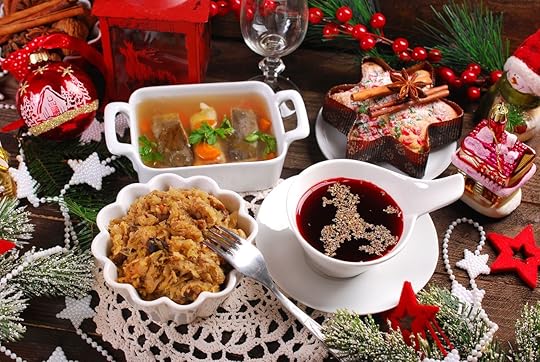
Photo: Teresa Kasprzycka/Shutterstock
The Wigilia is a traditional Christmas Eve supper that many Polish families serve. Quite poetically, the name Wigilia is derived from the Latin word for vigil, so the meal is sometimes colloquially known as the Star Supper. Accordingly, dinner starts when the first star appears in the sky. Fish is the star of this meal, especially carp, which is thought to bring good luck. The fish is traditionally fried in breadcrumbs and then baked. Herring fillets and pickled herring rollmops are also popular choices. Twelve dishes are traditionally served over the course of the meal (one dish for each apostle in the Bible), so you’ll also find fish elsewhere on the table like in perogies and mushroom soup.
A couple of other traditions accompany the Wigilia dinner that are worth mentioning. Some families lay hay under the table as a reminder that Jesus was born in a manger. Aleks’s family placed straw on the table on which they laid a figurine of baby Jesus. Another notable custom involves setting an extra seat at the table in case there’s an unexpected guest.
“The idea is that if someone should knock on your door during the Wigilia dinner, you should invite that person to eat with you,” Aleks says. “If a fellow human being came to you on this holiest of holy days asking for your generosity, it would be especially wrong to refuse them.”
2. Czech Republic

Photo: juliekrocova/Shutterstock
In the Czech Republic, Christmas Eve is known as Generous Day, an event filled with cooking, feasting, and celebration. Soup plays an important role in the festivities: Those who are able to subsist on fish and cabbage soup during the day might be rewarded with a vision of the golden pig in the evening — a sign of prosperity for the year to come.
At dinner, fried carp is the main course (a common theme among many of the countries on this list), served with potato salad. One perhaps now antiquated custom is to place fish scales under the plates, as it’s thought to bring wealth to the household.
3. Croatia

Photo: Katrinshine/Shutterstock
Badnji Dan (Christmas Eve Day) and Badnja Večer (Christmas Eve Night) are the major celebrations during the Croatian holiday season; the names are derived from Slavic word badar, meaning to stay awake, a reference to the fact that some families like to stay awake all night partying before greeting Christmas Day.
Croatians fast during the day on Christmas Eve and then enjoy a meal in the evening. Dried and salted cod, called bakalar, is the main dish. The cod is soaked for two days to remove the excess salt before cooking, then prepared as a stew with potatoes, parsley, and garlic.
4. Italy

Photo: Brent Hofacker/Shutterstock
Though the Feast of the Seven Fishes is an Italian-American tradition celebration in the United States, this sumptuous meal has its roots in Italy, where this seafood-heavy dinner is known as la cena della vigilia — the midnight vigil awaiting the birth of Christ.
Food writer Mark Cirillo explains that the fish dishes served at this meal vary depending on the region: In Rome, for example, arzilla fish soup is a popular choice, while cod fritters are more commonplace in Naples. Seafood of all kinds, not just fish, is also served, including clams and calamari.
One of the most illustrative stories that shows just how important it is to carry on traditions from the old country in America comes from the book Italian Family Christmas by Molly Totoro. When she and her Italian husband moved to Kansas City from Connecticut in 1990, they left behind a close family friend named Cora, who hailed from Cassano Irpino, near Naples. Determined to carry on the traditional la cena della vigilia usually hosted by Cora, Totoro searched her new hometown for baccala, the salted cod served as the dinner’s main course. Unable to track down a suitable fish (tilapia was the closest option but not good enough), Totoro was devastated. Then, Cora, back home in Bridgeport, came to the rescue. She went to her local Italian grocer, picked up a whole frozen fish in butcher paper and plastic wrap, and mailed it to Totoro in Kansas City so that she could honor her family’s heritage at the Christmas dinner table for another year.
5. Hungary
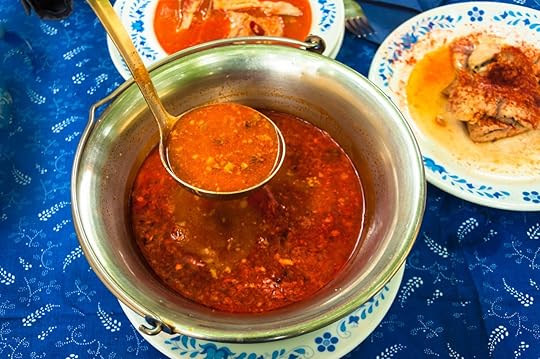
Photo: Pfeiffer/Shutterstock
On Christmas Eve, known as Szent-este or Holy Evening, Hungarians eat halászlé, a spicy “fisherman’s stew” made with some combination of carp, catfish, and fogas (perch). The key ingredient is paprika, which lends this soup its rich red color and signature kick. As in Poland, carp is considered good luck in Hungary. Halászlé is often served with stuffed cabbage and a poppy seed roll called beigli. After dinner, some families attend Midnight Mass.
6. Finland

Photo: DreamerAchieverNoraTarvus/Shutterstock
Baked ham, rutabaga casserole, and beet salad are usually the centerpiece of the Christmas dinner, called the Joulupöytä or the Yule Table in Finland. However, the meal often begins with a spread of fish-centric cold cuts, including smoked salmon and gravlax, lutefisk, fish roe, and pickled herring, all served with a side of boiled potatoes.
7. Fiji
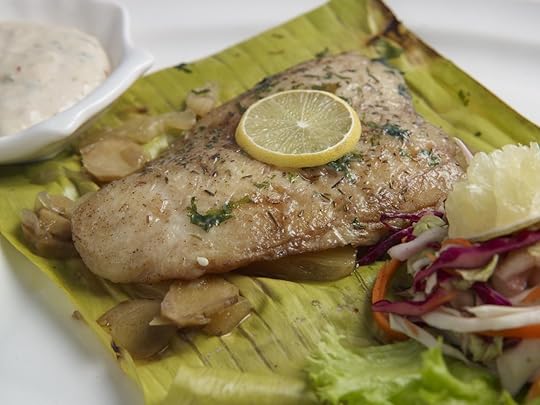
Photo: iris stock/Shutterstock
Here’s one country where Catholic traditions have nothing to do with the Christmas seafood feast. In Fiji, Christmas is celebrated with a lovo feast consisting of chicken seasoned with garlic, cassava, dalo root (also known as taro), pork, and, of course, fish (which might include mahi-mahi, tuna, and other seafood like octopus) — all marinated in tropical flavors like lime, ginger, and coconut cream. The lovo is a pit dug into the ground, into which stones are piled and a fire lit to heat the stones. Once the meat and fish are added to the pot, it’s covered with coconut stalks, large leaves, and damp fabric, then buried under a layer of soil until the food is cooked. To some people the flavor might be reminiscent of a smoky barbecue.
8. Sweden

Photo: Gutta100/Shutterstock
Christmas dinner is called Julbord in Sweden. The meal starts with cold fish and meats before moving on to hot dishes. There’s an abundance of herring at the dinner table, served both pickled and in herring salad. As in Finland, you might also encounter lutfisk. Small bites, like hard-boiled eggs topped with a scoop of fish roe, get guests excited about the meal to come. Salmon, whether it’s cured or smoked, is another popular appetizer, sometimes served on toast and topped with dill or mustard. One classic side dish is called gubbröra, a mixture of chopped hard-boiled eggs and anchovies.
9. Germany
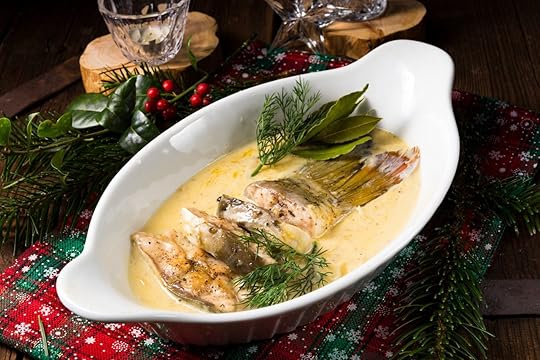
Photo: Gutta100/Shutterstock
Some Catholic Germans prepare a light, meatless dinner on Christmas Eve. Red herring salad — a mix of pickled cucumbers, beets, and apples — is a classic side dish. The weihnachtskarpfen (Christmas carp) is prepared in a variety of ways. Blue carp, so named because hot vinegar is poured over the fish until it takes on a blueish tint, is simmered in a herbaceous broth until cooked through and served with a side of horseradish sauce. It can also be breaded and fried and served with potato salad. Salmon or even hake (a member of the cod family) might also be served with sauerkraut.
In Germany, fish scales are sometimes carried in the wallet as a charm to attract wealth, based on the superstition that the scales resemble coins. Another old custom calls for burying the fish bones under a tree on Christmas so that it bears fruit in the coming year. 
More like thisWhat Christmas dinner looks like around the world
The post 9 countries where it’s not Christmas dinner without fish appeared first on Matador Network.

British Virgin Islands reopens

The British Virgin Islands is now open for tourism, but like most Caribbean destinations, you’ll have to prove you’re COVID-free before entering.
The British Virgin Islands, a group of 60 islands east of Puerto Rico, reopened its borders to travelers on December 1 with strict restrictions, including multiple testing requirements and a short quarantine period.
To visit, you’ll have to register online at the BVI Gateway at least seven days before your travel date, and then take a COVID-19 PCR test within five days of arrival, the results of which you’ll need to upload online. You must also submit proof of payment for your required four-day quarantine at an approved accommodation, as well as proof of medical travel insurance covering COVID-19. To cap off the online requirements, you’ll also be asked to pay a $175 COVID-19 entry fee, before receiving your Travel Authorization Certificate.
Upon arrival, you must take another PCR test at the airport and activate contact tracing on your phone. On the fourth day of your quarantine, you’ll have to take another PCR test and you’ll only be allowed to explore the island freely if the results come back negative.
New health and safety protocols will also be in place at the airport and around the island, including contactless services, hands-free automated doors, protection barriers, isolation rooms, touchless restroom facilities, and more. 
More like thisBeaches + IslandsThe 7 best outdoor adventures in the British Virgin Islands
The post The British Virgin Islands has finally reopened its borders to tourism appeared first on Matador Network.

What are Mexico’s pueblos mágicos?

There are a lot of magical towns in the world. According to Mexico’s secretary of tourism, there are over 130 magical towns in Mexico alone. Officially.
In 2001, Mexico’s tourism department launched the Pueblos Mágicos program to help generate tourism in rural areas. Huasca de Ocampo in the landlocked Hidalgo state was the first town awarded magical status. The list grew steadily until 2010 when the program was relaunched with more government support to help increase the tourism infrastructure in designated towns. Today, there are 132 pueblos mágicos spread across Mexico’s 31 states, including 11 new additions that were announced earlier this year.
The criteria to become a magical town is relatively straightforward: Destinations must have a population of at least 5,000, be in reasonable proximity to a bigger city, and offer touristic value. Towns must also appoint a committee to submit a plan for developing tourism with their application. Once approved, this committee is also responsible for maintaining the town’s designation. In return, the Pueblos Mágicos program aims to spotlight the unique cultures, histories, crafts, festivals, and landscapes of its featured destinations.
A handful of Mexico’s magical towns likely ring a bell: Tulum, Sayulita, and Isla Mujeres among them. Most, however, are probably unfamiliar to the average traveler. Whether you’re mapping the ultimate Mexican itinerary or daydreaming about lesser-known destinations, we’ve rounded up seven of our favorite pueblos mágicos to inspire your next visit to Mexico.
1. Mazunte, Oaxaca
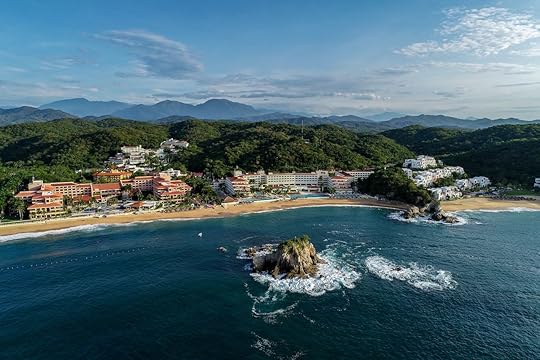
Photo: Goce la vida/Shutterstock
Mazunte is a beach town with tons of tourist appeal but surprisingly few tourists. It’s a hit with surfers and New Age types, with everything from yoga retreats and reiki studios to tattoo parlors, falafel spots, and eco-friendly cabins to keep travelers cozy.
Beyond the sun, sand, and surf, visitors enjoy basking in the scenery from the Punta Cometa lookout and watching for extraordinary sea life. Home to the National Mexican Turtle Center, Mazunte sits on some of the prime nesting beaches for the many sea turtle species that call the Mexican coast home. Dolphin, whale, and manta ray sightings are also common here, as a bonus.
2. Palenque, Chiapas

Photo: Jess Kraft/Shutterstock
Downtown Palenque is charming if a little underwhelming. The real draw to this altiplano town is the nearby Mayan temple complex, which has one of the finest examples of Mexico’s pre-Colombian architecture. Smaller than Chichen Itza, the ancient three-level city is no less impressive with over 1,000 limestone palaces, tombs, temples, pools, courtyards, and other structures, plus notable stucco artifacts and low-relief carvings.
Eight small rivers flow through the ancient city, but if it’s refreshing water you’re after, save some energy to explore the area’s waterfalls. Several falls, each a different size and shape, surround Palenque. We recommend Roberto Barrios if you only have time for one.
3. Atlixco, Puebla
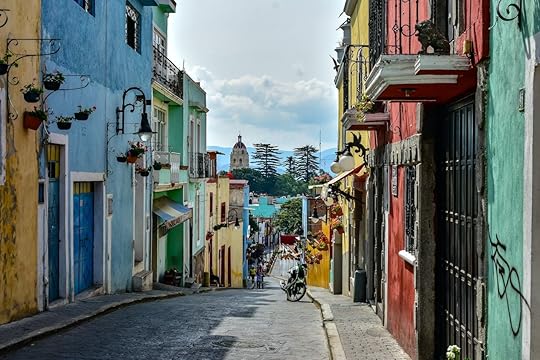
Photo: Marcos E Ramos Ponciano/Shutterstock
Around Mexico, Atlixco is famous for a few reasons: It sits at the feet of twin volcanoes Popocatépetl and Iztaccíhuatl. It’s one of Mexico’s leading flower producers. And the town’s Marconi Point is among the most active places for UFO sightings anywhere in the world.
Atlixco’s annual flower festival and Christmastime poinsettia fair are two of the best times to see the town in all its floral glory. Holidays like Holy Week and Día de los Muertos also see the streets carpeted in bright blooms. But the biggest celebration is held in September when residents from all over Puebla gather to sing, dance, and observe indigenous culture during El Huey Atlixcáyotl in honor of Quetzalcóatl. This festival also coincides with the annual feast for the patron saint San Miguel, who lent his name to Atlixco’s 18th-century chapel.
4. Bacalar, Quintana Roo
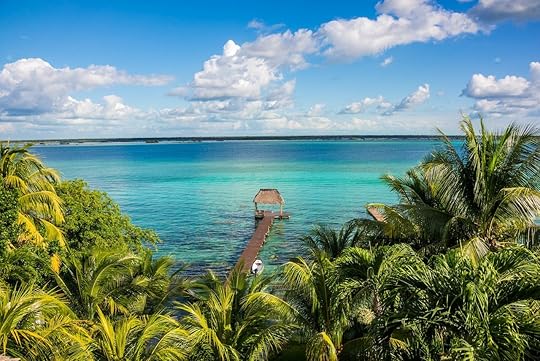
Photo: DC_Aperture/Shutterstock
Between Cancún and the Riviera Maya, Quintana Roo has come to define tourism on Mexico’s Yucatán Peninsula. Fewer travelers know that Bacalar is there, too.
Farther down the coast on the Belizean border, Bacalar is often likened to a pre-trendy Tulum. Trips here are about slowing down and tuning into nature, from horseback rides and jungle treks to kayaking the Lake of Seven Colors and snorkeling the lagoon’s seven cenotes. Expect fresh seafood from hipster-free restaurants here, but don’t come to Bacalar looking for nightlife.
5. San Sebastián Bernal, Querétaro

Photo: LukeandKarla.Travel/Shutterstock
This small town in Querétaro has one monolithic claim to fame: Peña de Bernal, which happens to be the third-largest monolith in the world. Pilgrims hike to the small chapel and pre-Hispanic stone cross at the top, which tourists may also enjoy. Just note that the final stretch is very challenging and requires some technical equipment. Guides are recommended.
Just 2.5 hours from Mexico City, the town for which the mighty boulder is named unfurls along stone lanes, with colorful buildings around every corner. Tasty street treats are equally plentiful. Gorging on gorditas is a must in Bernal, as is sampling as much of the local candy as you can stomach. For the cherry on top, admire even more desserts at the town’s sweets museum.
6. Xilitla, San Luis Potosí

Photo: Eleni Mavrandoni/Shutterstock
Located in the tropical La Huasteca Potosina subregion of San Luis Potosí, Xilitla’s crowning attraction is Las Pozas, a jungle sculpture garden created by art collector and poet Edward James.
Las Pozas builds on Xilitla’s natural beauty by weaving surreal, temple-like structures into the waterfall-laden surroundings. If touring the enchanting garden only makes you want to dive deeper into the scenery, Xilitla also caters to the adventurous crowd with opportunities to hike, mountain bike, rappel, raft, and more. If you can do it in the jungle, you can do it here.
7. Tepoztlán, Morelos
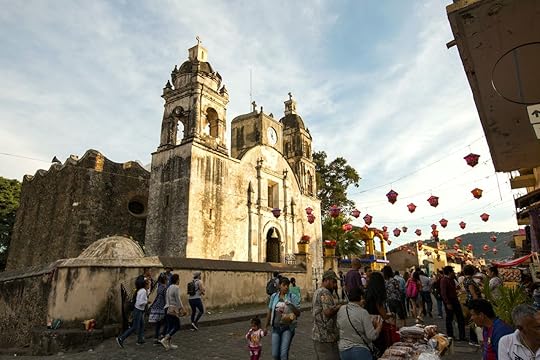
Photo: Matt Gush/Shutterstock
Tepoztlán was among the first towns to earn pueblo mágico status. According to legend, it’s believed to be the birthplace of Quetzalcóatl, the Aztec serpent god. A small temple atop the Sierra de Tepoztlán also honors Tepoztecatl, the god of pulque, an ancient alcoholic drink.
Following a brief hiccup in 2009 when it lost its designation, Tepoztlán was reinstated as a pueblo mágico in 2010 owing to its thriving indigenous culture. Not only are you likely to encounter Náhuatl speakers here, but the weekly craft market has also been called the best in central Mexico. You can even taste pre-Hispanic recipes like tlaltequeadas there.
Elsewhere, Tepoztlán is a holistic center with masseurs, tarot card readers, and seers. And if that’s not your thing, we dare you not to be wowed by the views at El Tepozteco National Park. 
More like thisArt + Architecture7 of the most beautiful small towns in Mexico
The post Mexico has more than 100 magical towns, and you’re gonna want to take note appeared first on Matador Network.

Favorite Christmas treat by state
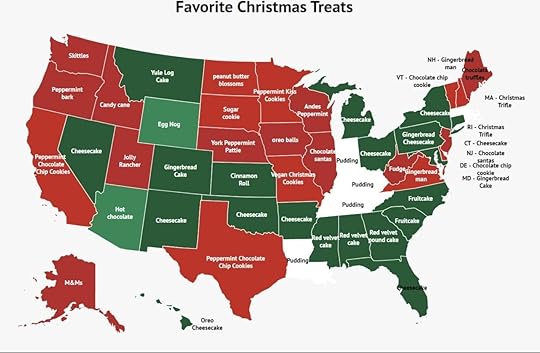
Halloween is the most candy-obsessed holiday, but don’t sleep on Christmas. Between Christmas cookies, candy canes, eggnog, and gingerbread men, there’s plenty of treats to go around before your New Year’s resolution kicks in. Naturally, the burning question arises: which Christmas treat is the most popular? Unsurprisingly, it varies by state. Zippia used Google Trends to find out the Christmas treats eaten in disproportionate amounts by each state — looking at over 40 classic Christmas desserts — and distilled the findings into a map.

Photo: Zippia
Surprisingly, cheesecake dominated in nine states, including Nevada, Ohio, and New York. Connecticut is particularly fond of gingerbread cheesecake. North Dakota is partial to peanut butter blossoms, which some of us definitely had to Google to learn what they were, while Iowa prefers oreo balls.
Other treats range from the conventional — like hot chocolate, candy canes, and gingerbread cookies — to the more unconventional like peppermint bark, Jolly ranchers, and vegan Christmas cookies (looking at you, Missouri). In an attempt to show up the rest of the country, Montana is a fan of yule log cake, which sounds like a dessert conceived by Santa Claus himself.
And you’ve gotta give props to Alaska and Oregon for not realizing Halloween is over and choosing M&Ms and Skittles, respectively. 
More like thisHolidaysThe 9 most dazzling Christmas trees around the world
The post This map shows the most popular Christmas treat in every state appeared first on Matador Network.

Michigan hotel offers ‘Elf’ suite

With Christmas vacations abroad mostly off the table this year, families are looking for creative ways to celebrate the holidays at home. One of the best options out there to do just that is a staycation at this Elf-themed hotel suite. The Royal Park Hotel in Rochester, MI, is offering a full suite completely decked out in honor of the movie Elf.

Photo: Royal Park Hotel/Facebook
Guests will be treated to food inspired by Buddy’s favorite food groups (candy, candy canes, candy corn, and syrup), receiving maple toasty tarts, chocolate-covered marshmallow snowballs, elf munch, and candy canes upon arrival.
The room is filled with nods to the movie, including a sign that says “Santa I know him” over the bed and over 5,000 feet of handmade paper snowflake decorations. There are also two Christmas trees — one with a Buddy the Elf theme and another decorated with Maker’s Mark goodies.

Photo: Royal Park Hotel/Facebook
Hotel spokesperson Sarah Osbourn said, “We thought it would be a really cool idea, especially with people not feeling safe this year, to offer a holiday experience in a suite for them, so they can still feel safe, still get into the holiday spirit and have something fun to do.”

Photo: Royal Park Hotel/Facebook
The suite starts at $499 per night, and reservations are available online.
But if you’re not able to book the suite for your dates, don’t worry — the hotel also has a gingerbread-inspired suite package and its lobby is decked out with holiday decor.

Photo: Royal Park Hotel/Facebook
Ten percent of the proceeds will go toward The Big, Bright Light Show, a holiday light show in downtown Rochester that sees its buildings illuminated by dazzling lights in December and January. 
More like thisFestivals12 places around the world that go all out with holiday lights
The post This Christmas, stay in a hotel suite inspired by the movie ‘Elf’ appeared first on Matador Network.

French man left money for cats

It’s not uncommon for generous donors to leave money to a museum or cultural institution. It’s less common, however, for them to leave money to the cats who live in those institutions.
A French man has recently left a sum of money in his will to the 50 cats residing in the famous Hermitage Museum in St. Petersburg, Russia. The museum, which is home to three million works of art, artifacts, and sculptures, is also home to the felines.
Cats have been residents of the Hermitage Museum since the 18th century, when Catherine the Great designated them as guardians of the art galleries. Now they’re largely cared for by volunteers and museum staff.
Mikhail Piotrovsky, the museum’s general director, said in a press conference, “Our French friend did a very good thing; this is brilliant PR for both the cats and charity. The sum is not very big but it’s very important when the person writes a will, when the French lawyers contact (us) and it’s all not a simple (process) but this is all very interesting, isn’t it?”
The money will probably be used to repair the museum’s basement, where the cats live. Others have previously left money for the cats, including Vladimir Fortov, former president of the Russian Academy of Sciences, who would often stop by and leave money for the basement-dwellers. 
More like thisPetsAdventure cats are taking over Instagram and coming for travel dogs’ reign
The post French man leaves money in his will for the cats living in Russia’s Hermitage Museum appeared first on Matador Network.

Matador Network's Blog
- Matador Network's profile
- 6 followers



